KitchenAid KFRU368TSS, KFRU365VSS, KFRU488VSS, KFRU368VSS, KFRS365TSS User Manual
...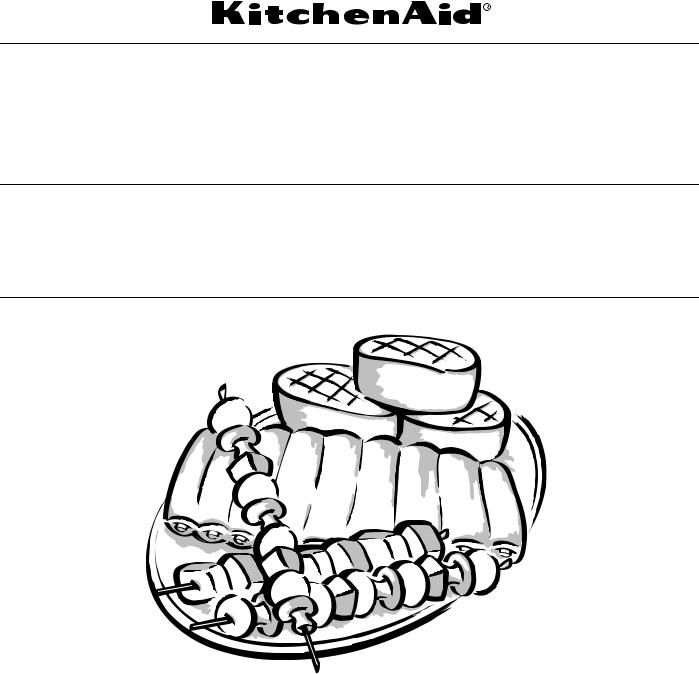
FREESTANDING OUTDOOR GRILLS
InstallationInstructionsandUse&CareGuide
For questions about features, operation/performance, parts, accessories or service, call: 1-800-422-1230 or visit our website at www.kitchenaid.com
In Canada, for assistance, installation and service, call: 1-800-807-6777 or visit our website at www.KitchenAid.ca
GRILS D'EXTÉRIEUR AUTOPORTANTS
Instructionsd’installationetGuided’utilisationetd’entretien
Au Canada, pour assistance, installation ou service composez le 1-800-807-6777 ou visitez notre site Web à www.KitchenAid.ca
Table of Contents/Table des matières............................................................................. |
2 |
IMPORTANT:
Save for local electrical inspector's use.
Installer: Leave installation instructions with the homeowner.
Homeowner: Keep installation instructions for future reference.
IMPORTANT :
À conserver pour consultation par l'inspecteur local des installations électriques. Installateur : Remettre les instructions d'installation au propriétaire. Propriétaire : Conserver les instructions d'installation pour référence ultérieure.
Models/Modèles KFRU271VSS, KFRU361VSS, KFRU365VSS, KFRU368VSS, KFRU488VSS, KFRS271TSS, KFRS361TSS, KFRS365TSS, KFRU368TSS, KFRU488TSS
W10175731B

TABLE OF CONTENTS |
|
OUTDOOR GRILL SAFETY............................................................ |
3 |
INSTALLATION REQUIREMENTS ................................................ |
5 |
Tools and Parts ............................................................................ |
5 |
Location Requirements................................................................ |
5 |
Product Dimensions .................................................................... |
6 |
Electrical Requirements ............................................................... |
6 |
Gas Supply Requirements ........................................................... |
7 |
Gas Connection Requirements.................................................... |
7 |
INSTALLATION INSTRUCTIONS .................................................. |
9 |
Freestanding Outdoor Grill Installation ........................................ |
9 |
GAS CONVERSIONS.................................................................... |
14 |
Tools and Parts for Gas Conversion.......................................... |
14 |
Conversion to a Local LP Gas Supply....................................... |
15 |
Conversion from LP Gas to Natural Gas ................................... |
16 |
Check and Adjust the Burners................................................... |
19 |
OUTDOOR GRILL USE ................................................................ |
20 |
ELECTRONIC GRILL DISPLAY ................................................... |
20 |
Display........................................................................................ |
20 |
Start/Reset ................................................................................. |
20 |
Mode .......................................................................................... |
20 |
Using Your Outdoor Grill............................................................ |
22 |
Using Your Infrared Sear Burner................................................ |
23 |
Using Your Side Burner ............................................................. |
23 |
Using Your Rotisserie................................................................. |
24 |
Rotisserie Cooking Tips ............................................................. |
26 |
Using Your Smoker Box ............................................................ |
27 |
Hood Lights................................................................................ |
27 |
USING YOUR WARMING DRAWER ........................................... |
27 |
Control Knob .............................................................................. |
27 |
Moist-Dry Slide Control.............................................................. |
28 |
Setting the Controls ................................................................... |
28 |
Warming Cookware ................................................................... |
29 |
Warming Pans and Positioning Rack ........................................ |
29 |
Proofing Bread ........................................................................... |
29 |
Slow Cook Function................................................................... |
29 |
TIPS FOR OUTDOOR GRILLING ................................................ |
30 |
Cooking Methods....................................................................... |
30 |
Grilling Chart............................................................................... |
31 |
OUTDOOR GRILL CARE ............................................................. |
33 |
Replacing the Batteries.............................................................. |
33 |
General Cleaning........................................................................ |
34 |
Drawer Slides ............................................................................. |
36 |
Drawer Removal......................................................................... |
36 |
Cabinet Door Alignment - Style 2 |
|
(internal hinge) Only.................................................................... |
36 |
Cabinet Door Removal............................................................... |
37 |
TROUBLESHOOTING .................................................................. |
38 |
ASSISTANCE OR SERVICE......................................................... |
39 |
WARRANTY .................................................................................. |
41 |
TABLE DES MATIÈRES |
|
SÉCURITÉ DU GRIL D'EXTÉRIEUR ........................................... |
43 |
EXIGENCES D'INSTALLATION ................................................... |
45 |
Outillage et pièces...................................................................... |
45 |
Exigences d'emplacement......................................................... |
45 |
Dimensions du produit .............................................................. |
46 |
Spécifications électriques .......................................................... |
46 |
Spécifications de l'alimentation en gaz ..................................... |
47 |
Exigences concernant le raccordement au gaz ........................ |
48 |
INSTRUCTIONS D'INSTALLATION............................................. |
49 |
Installation du gril d'extérieur autoportant ................................. |
49 |
CONVERSIONS DE GAZ.............................................................. |
54 |
Outillage et pièces pour la conversion....................................... |
54 |
Conversion au gaz propane local .............................................. |
55 |
Conversion de gaz propane à gaz naturel................................. |
56 |
Contrôle et réglage des brûleurs................................................ |
59 |
UTILISATION DU GRIL D'EXTÉRIEUR....................................... |
60 |
AFFICHEUR ÉLECTRONIQUE DU GRIL .................................... |
61 |
Afficheur ..................................................................................... |
61 |
Start/Reset (démarrage/réinitialisation)...................................... |
61 |
Mode........................................................................................... |
61 |
Utilisation du gril d'extérieur....................................................... |
62 |
Utilisation du brûleur à infrarouge.............................................. |
64 |
Utilisation du brûleur latéral........................................................ |
64 |
Utilisation du tournebroche........................................................ |
65 |
Conseils de cuisson à l’aide du tournebroche .......................... |
66 |
Utilisation du fumoir ................................................................... |
67 |
Lampes du capot ....................................................................... |
67 |
UTILISATION DU TIROIR-RÉCHAUD......................................... |
68 |
Bouton de commande ............................................................... |
68 |
Curseur de réglage Moist-Dry (humide-sec).............................. |
68 |
Réglage des commandes .......................................................... |
68 |
Ustensiles de réchauffage.......................................................... |
69 |
Ustensiles de réchauffage et grille de positionnement.............. |
69 |
Levée du pain ............................................................................. |
70 |
Fonction de cuisson lente .......................................................... |
70 |
CONSEILS POUR L'UTILISATION DU GRIL D'EXTÉRIEUR ... |
70 |
Méthodes de cuisson................................................................. |
71 |
Tableau de cuisson au gril ......................................................... |
72 |
ENTRETIEN DU GRIL D'EXTÉRIEUR ......................................... |
74 |
Changement de l'ampoule d'éclairage...................................... |
74 |
Nettoyage général ...................................................................... |
75 |
Glissières de tiroir....................................................................... |
77 |
Dépose du tiroir.......................................................................... |
77 |
Alignement de la porte du placard - |
|
Style 2 (charnière interne) uniquement ...................................... |
78 |
Dépose de la porte du placard .................................................. |
78 |
DÉPANNAGE................................................................................. |
79 |
ASSISTANCE OU SERVICE......................................................... |
81 |
GARANTIE..................................................................................... |
82 |
2
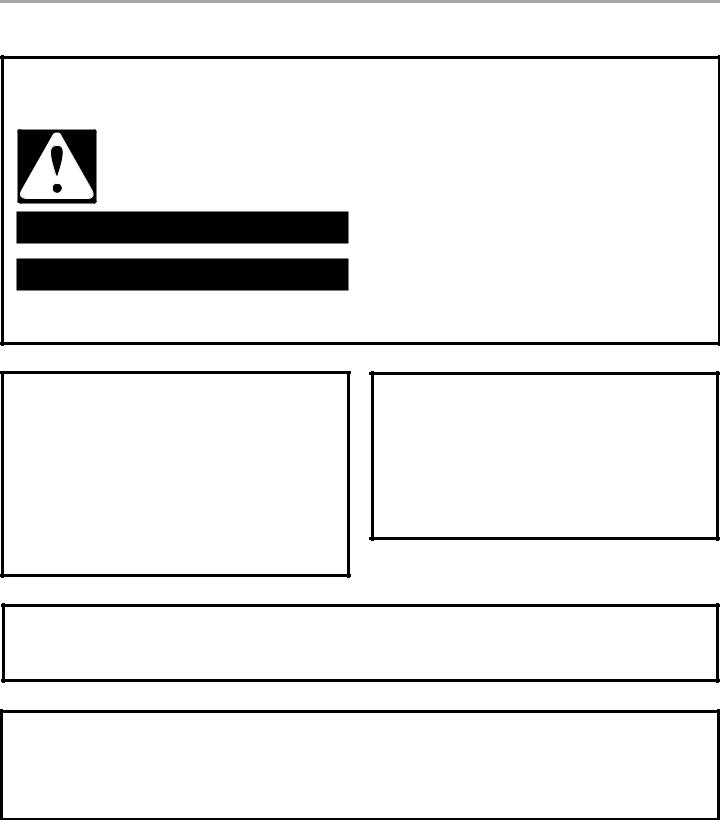
OUTDOOR GRILL SAFETY
Your safety and the safety of others are very important.
We have provided many important safety messages in this manual and on your appliance. Always read and obey all safety messages.
This is the safety alert symbol.
This symbol alerts you to potential hazards that can kill or hurt you and others.
All safety messages will follow the safety alert symbol and either the word “DANGER” or “WARNING.” These words mean:
 DANGER
DANGER
 WARNING
WARNING
You can be killed or seriously injured if you don't immediately follow instructions.
You can be killed or seriously injured if you don't follow instructions.
All safety messages will tell you what the potential hazard is, tell you how to reduce the chance of injury, and tell you what can happen if the instructions are not followed.
 DANGER
DANGER
If you smell gas:
1.Shut off gas to the appliance.
2.Extinguish any open flame.
3.Open lid.
4.If odor continues, keep away from the appliance and immediately call your gas supplier or your fire department.
 WARNING
WARNING
1.Do not store or use gasoline or other flammable liquids or vapors in the vicinity of this or any other appliance.
2.An LP cylinder not connected for use shall not be stored in the vicinity of this or any other appliance.
State of California Proposition 65 Warnings:
WARNING: This product contains a chemical known to the State of California to cause cancer.
WARNING: This product contains a chemical known to the State of California to cause birth defects or other reproductive harm.
In the State of Massachusetts, the following installation instructions apply:
■Installations and repairs must be performed by a qualified or licensed contractor, plumber, or gasfitter qualified or licensed by the State of Massachusetts.
■If using a ball valve, it shall be a T-handle type.
■A flexible gas connector, when used, must not exceed 3 feet.
IMPORTANT: This grill is manufactured for outdoor use only. For grills that are to be used at elevations above 2000 ft (609.6 m) orifice conversion is required. See “Gas Supply Requirements” section. It is the responsibility of the installer to comply with the minimum installation clearances specified on the model/serial rating plate. The model/serial rating plate for freestanding models can be found on the right-hand inside cabinet wall.
3

IMPORTANT SAFETY INSTRUCTIONS
WARNING: To reduce the risk of fire, electrical shock, injury to persons, or damage when using the outdoor cooking gas appliance, follow basic precautions, including the following:
■Do not install portable or built-in outdoor cooking gas appliances in or on a recreational vehicle, portable trailer, boat or in any other moving installation.
■Always maintain minimum clearances from combustible construction, see “Location Requirements” section.
■The outdoor cooking gas appliance shall not be located under overhead unprotected combustible construction.
■This outdoor cooking gas appliance shall be used only outdoors and shall not be used in a building, garage, or any other enclosed area.
■Keep any electrical supply cord and fuel supply hose away from any heated surfaces.
■Keep outdoor cooking gas appliance area clear and free from combustible materials, gasoline and other flammable vapors and liquids.
■Do not obstruct the flow of combustion and ventilation air. Keep the ventilation openings of the cylinder enclosure free and clear from debris.
■Inspect the gas cylinder supply hose before each use of the outdoor cooking gas appliance. If the hose shows excessive abrasion or wear, or is cut, it MUST be replaced before using the outdoor cooking gas appliance. Contact your dealer and use only replacement hoses specified for use with the outdoor cooking gas appliance.
■Visually check the burner flames. They should be blue. Slight yellow tipping is normal for LP gas.
■Check and clean burner/venturi tube for insects and insect nest. A clogged tube can lead to fire under the outdoor cooking gas appliance.
■The LP gas supply cylinder to be used must be:
-constructed and marked in accordance with the Specification for LP Gas Cylinders of the U.S. Department of Transportation (DOT) or the National Standard of Canada, CAN/CSA-B339, Cylinders, Spheres, and Tubes for Transportation of Dangerous Goods; and Commission.
-provided with a listed overfilling prevention device.
-provided with a cylinder connection device compatible with the connection for outdoor cooking gas appliances.
■Always check connections for leaks each time you connect and disconnect the LP gas supply cylinder. See “Installation Instructions” section.
■When the outdoor cooking gas appliance is not in use, the gas must be turned off at the supply cylinder.
■Storage of an outdoor cooking gas appliance indoors is permissible only if the cylinder is disconnected and removed from the outdoor cooking gas appliance.
■Cylinders must be stored outdoors and out of the reach of children and must not be stored in a building, garage, or any other enclosed area.
■The pressure regulator and hose assembly supplied with the outdoor cooking gas appliance must be used. A replacement pressure regulator and hose assembly specific to your model is available from your outdoor cooking gas appliance dealer.
■Gas cylinder must include a collar to protect the cylinder valve.
■For appliances designed to use a CGA791 Connection: Place a dust cap on cylinder valve outlet whenever the cylinder is not in use. Only install the type of dust cap on the cylinder valve outlet that is provided with the cylinder valve. Other types of caps or plugs may result in leakage of propane.
If the following information is not followed exactly, a fire causing death or serious injury may occur.
■Do not store a spare LP gas cylinder under or near this outdoor cooking gas appliance.
■Never fill the cylinder beyond 80 percent full.
SAVE THESE INSTRUCTIONS
4

INSTALLATION REQUIREMENTS
ToolsandParts
Gather the required tools and parts before starting installation. Read and follow the instructions provided with any tools listed here.
Tools Needed
■ |
Tape measure |
■ |
Wrench or pliers |
■ |
Small, flat-blade screwdriver |
■ |
Pipe wrench |
■ |
Flat-blade screwdriver |
■ |
Scissors or cutting pliers |
■ #2 and #3 Phillips screwdriver |
|
(to remove tiedowns) |
|
|
Noncorrosive leak- |
||
■ |
Level |
■ |
|
|
detection solution |
||
|
|
|
|
■Short Phillips screwdriver or a 90° screwdriver with a Phillips screw bit
Parts Supplied
■Gas pressure regulator/hose assembly set for 11" WCP LP gas (attached to manifold)
■Natural gas conversion kit with convertible regulator set for 4" WCP Natural gas (on some models)
■Natural gas conversion kit (on some models)
■Rotisserie motor mounting bracket (on some models)
■Rotisserie motor (on some models)
■Rotisserie forks (on some models)
■Rotisserie spit (on some models)
■Smoker box (on some models)
■2 warming drawer pans (on some models)
■1 single-prong plug/500 mAmp transformer assembly for the rotisserie motor (on some models)
■2 - 1.5 V “D” size alkaline batteries (on some models)
■Vinyl grill cover (on some models)
Parts Needed
■20 lb LP gas fuel tank - approximately 18" (45.7 cm) height and 12" (30.5 cm) diameter
■UL outdoor-rated 120 V extension cord - size 14 gauge/3 wire (marked 14/3 W-A), 50 foot (15.2 m) maximum length
LocationRequirements
 WARNING
WARNING
Explosion Hazard
Do not store fuel tank in a garage or indoors.
Do not store grill with fuel tank in a garage or indoors.
Failure to follow these instructions can result in death, explosion, or fire.
 WARNING
WARNING
Fire Hazard
Do not use grill near combustible materials.
Do not store combustible materials near grill.
Doing so can result in death or fire.
Select a location that provides minimum exposure to wind and traffic paths. The location should be away from strong draft areas.
Do not obstruct flow of combustion and ventilation air.
Clearance to combustible construction for freestanding outdoor grills:
■A minimum of 24" (58 cm) must be maintained between the front of the grill hood, sides and back of the grill and any combustible construction.
■A 24" (58 cm) minimum clearance must also be maintained below the cooking surface and any combustible construction.
Rotisserie
A 6" (15.2 cm) minimum clearance is needed for the rotisserie motor.
A grounded, 3-prong outdoor outlet is located on the back of the grill. See “Electrical Requirements” section.
NOTE: The rotisserie is an accessory on some models. See the “Assistance or Service” section to order.
5
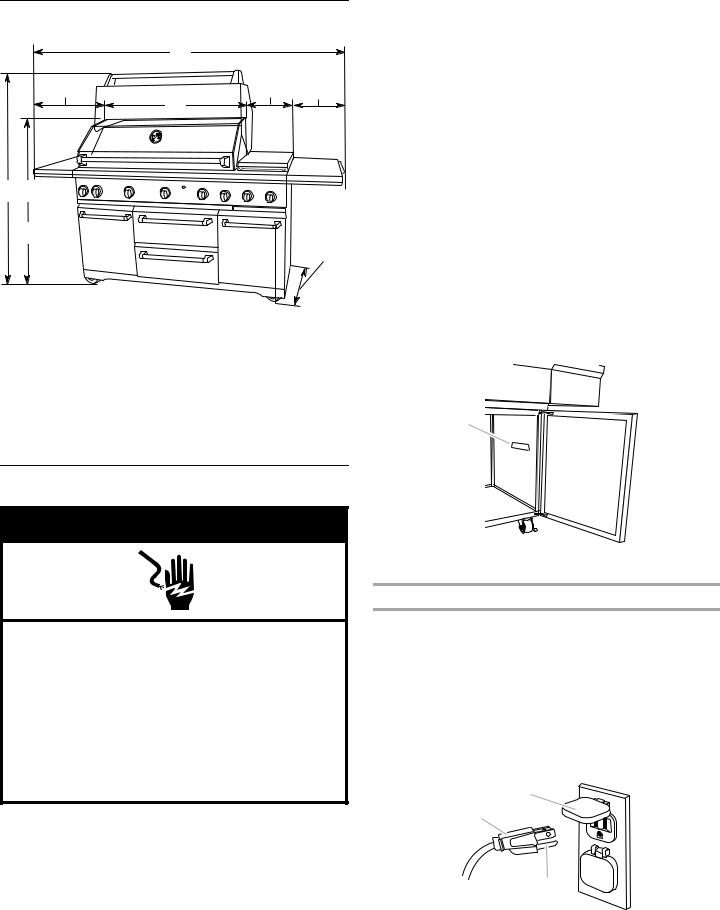
|
ProductDimensions |
|
A |
17¼" |
17¼" |
(43.8 cm) |
C (43.8 cm) |
B
62⁄" |
|
(158.7 cm) |
|
|
28¹⁄" |
50¹⁄" |
(72.4 cm) |
(127.2 cm) |
front of |
|
handle to |
|
back of grill |
A.61½" (156.2 cm) on 27" (68.6 cm) models KFRS271T and KFRU271V 70½" (179.1 cm) on 36" (91.4 cm) models KFRS361T, KFRU361V, KFRS365T and KFRU365V
84½" (214.6 cm) on 36" (91.4 cm) models with side burner - KFRU368T and KFRU368V
96½" (245.1 cm) on 48" (121.9 cm) models with side burner - KFRU488T and KFRU488V
B.27" (68.6 cm) 36" (91.4 cm) 48" (121.9 cm)
C.Not available on 27" (68.6 cm) models
14" (35.6 cm) on 36" (91.4 cm) and 48" (121.9 cm) models
ElectricalRequirements
 WARNING
WARNING
Electrical Shock Hazard
Use only a UL listed, 14 gauge, 3 wire extension cord approved for outdoor use, marked W-A, with a maximum length of 50 ft.
Plug into a grounded 3 prong outlet.
Do not remove ground prong.
Do not use an adapter.
Failure to follow these instructions can result in death, fire, or electrical shock.
If codes permit and a separate ground wire is used, it is recommended that a qualified electrician determine that the ground path is adequate.
Check with a qualified electrician if you are not sure whether the grill is properly grounded.
A 120-volt, 60-Hz, AC-only, 15-amp, fused electrical supply is required.
It is recommended that a separate circuit servicing only this grill be provided.
■To avoid electrical shock, do not immerse cord or plugs in water or other liquid.
■Unplug from the outlet when not in use and before cleaning. Allow to cool before putting on or taking off parts.
■Do not operate any outdoor cooking gas appliance with a damaged cord, damaged plug, or after the appliance malfunctions or has been damaged in any manner. Contact the manufacturer for repair.
■Do not let the cord hang over the edge of a table or touch hot surfaces.
■Do not use an outdoor cooking appliance for purposes other than intended.
■When connecting, first connect plug to the outdoor cooking gas appliance then plug appliance into the outlet.
■Use only a Ground Fault Interrupter (GFI) protected circuit with this outdoor cooking gas appliance.
■Do not remove the ground prong or use with an adapter of 2 prongs.
■Use only extension cords with a 3 prong grounding plug rated for the power of the equipment and approved for outdoor use with a W-A marking.
The model/serial number rating plate is located inside the grill cabinet on the right-hand cabinet side. See the following illustration.
A
A. Model/serial number plate
Recommended Ground Method
The outdoor grill, when installed, must be electrically grounded in accordance with local codes or, in the absence of local codes, with the National Electrical Code ANSI/NFPA 70, or Canadian Electrical Code, CSA C22.1.
Copies of the standards listed above may be obtained from:
CSA International
8501 East Pleasant Valley Rd.
Cleveland, Ohio 44131-5575
National Fire Protection Association
One Batterymarch Park
Quincy, Massachusetts 02269
B
A
C
A.3-prong ground plug
B.3-prong polarized type outdoor GFI outlet
C.Ground prong
6

GasSupplyRequirements
 WARNING
WARNING
Explosion Hazard
Use a new CSA International approved “outdoor” gas supply line.
Securely tighten all gas connections.
If connected to LP, have a qualified person make sure gas pressure does not exceed 11” (28 cm) water column.
Examples of a qualified person include:
licensed heating personnel,
authorized gas company personnel, and authorized service personnel.
Failure to do so can result in death, explosion, or fire.
Observe all governing codes and ordinances.
IMPORTANT: This installation must conform with all local codes and ordinances. In the absence of local codes, installation must conform with American National Standard, National Fuel Gas Code ANSI Z223.1 - latest edition or CAN/CGA B149.1 - latest edition.
IMPORTANT: Grill must be connected to a regulated gas supply.
Refer to the model/serial rating plate for information on the type of gas that can be used. If this information does not agree with the type of gas available, check with your local gas supplier.
Gas Conversion:
No attempt shall be made to convert the grill from the gas specified on the model/serial rating plate for use with a different gas type without consulting the serving gas supplier. The conversion kit supplied with grill must be used. See “Gas Conversions” section for instructions.
Gas Pressure Regulator
The gas pressure regulator supplied with this grill must be used. The inlet (supply) pressure to the regulator should be as follows for proper operation:
LP Gas:
Operating pressure: 11" (27.9 cm) WCP
Inlet (supply) pressure: 11" to 14" (27.9 cm to 35.5 cm) WCP
Natural Gas:
Operating pressure: 4" (10.2 cm) WCP
Inlet (supply) pressure: 7" to 14" (17.8 cm to 35.5 cm) WCP maximum.
Contact local gas supplier if you are not sure about the inlet (supply) pressure.
Burner Requirements for High Altitude
Input ratings shown on the model/serial rating plate are for elevations up to 2,000 ft (609.6 m).
For elevations above 2,000 ft (609.6 m), ratings are reduced at a rate of 4% for each 1,000 ft (304.8 m) above sea level. Orifice conversion is required. See “Assistance or Service” section to order.
Gas Supply Line Pressure Testing
Testing above ½ psi (3.5 kPa) or 14" (35.5 cm) WCP (gauge):
The grill and its individual shutoff valve must be disconnected from the gas supply piping system during any pressure testing of that system at test pressures greater than ½ psi (3.5 kPa).
Testing below ½ psi (3.5 kPa) or 14" (35.5 cm) WCP (gauge) or lower:
The grill must be isolated from the gas supply piping system by closing its individual manual shutoff valve during any pressure testing of the gas supply piping system at test pressures equal to or less than ½ psi (3.5 kPa).
GasConnectionRequirements
20 lb LP Gas Fuel Tank
This grill is equipped for use with a 20 lb LP gas fuel tank (fuel tank not supplied). A gas pressure regulator/hose assembly is supplied.
It is also design-certified by CSA International for local LP gas supply or for Natural gas with appropriate conversion.
A
A. Gas pressure regulator/hose assembly
The 20 lb LP gas fuel tank must be mounted and secured.
Drawer Style Tank Tray
1.Open the drawer for the 20 lb LP gas fuel tank.
2.Place the 20 lb LP gas fuel tank bottom collar into the mounting hole in the tank tray.
3.Tighten the locking screw against the bottom collar of the 20 lb LP gas fuel tank to secure.
A 
BC
A.Locking screw
B.Mounting hole
C.Bottom collar
4.Slide the drawer with the 20 lb LP gas fuel tank back into the cabinet.
7

Door Style Tank Tray
1.Open cabinet doors.
2.Press the locking tab on the tank tray and pull out the tray.
A 

A.20 lb LP gas fuel tank tray locking tab
3.Place the 20 lb LP gas fuel tank bottom collar into the mounting hole in the tank tray.
4.Tighten the locking screw against the bottom collar of the 20 lb LP gas fuel tank to secure.
A 
BC
A.Locking screw
B.Mounting hole
C.Bottom collar
5.Slide the tank tray back into the cabinet and lock into place.
Local LP Gas Supply Conversion
Conversion must be made by a qualified gas technician. The qualified gas technician shall provide the gas supply to the selected grill location in accordance with the National Fuel Gas Code ANSI Z223.1/NFPA 54 - latest edition, and local codes. For conversion to local LP, the convertible regulator in the conversion kit supplied with the grill (on some models) must be used. Models that do not come with the conversion kit require Convertible Regulator Part Number W10132702. See “Assistance or Service” section for information on ordering.
IMPORTANT: The gas installation must conform with local codes, or in the absence of local codes, with the National Fuel Gas Code, ANSI Z223.1/NFPA 54 - latest edition. The qualified LP gas technician shall provide the LP gas supply to the selected grill location in accordance with the National Fuel Gas Code, ANSI Z223.1/NFPA 54 and local codes.
Follow instructions for converting to local LP gas in the “Gas Conversions” section.
A |
B
C
A.New ANSI Z21.54 certified gray hose
B.Rear of grill
C.To local LP gas supply
The gas supply line shall be equipped with an approved shutoff valve. This valve should be located in the same area as the grill and should be in a location that allows ease of opening and closing. Do not block access to the shutoff valve. The valve is for turning on or shutting off gas to the grill.
B
A
C
A.Gas supply line
B.Shutoff valve “open” position
C.To grill
8
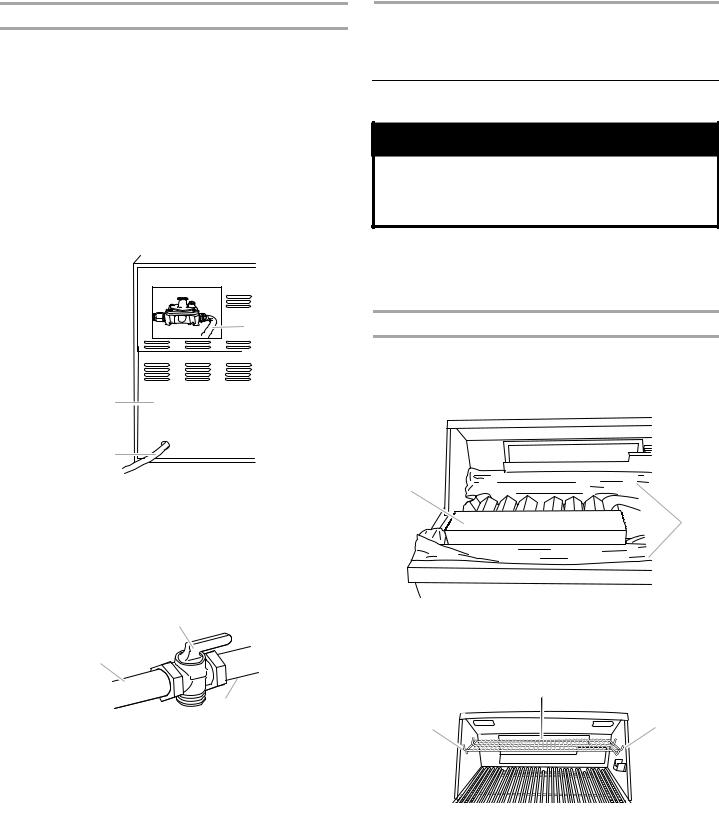
Natural Gas Conversion
Conversion must be made by a qualified gas technician. The qualified Natural gas technician shall provide the Natural gas supply to the selected grill location in accordance with the National Fuel Gas Code ANSI Z223.1/NFPA 54 - latest edition, and local codes. For conversion to Natural gas, the Natural Gas Conversion Kit supplied with the grill (on some models) or the Natural Gas Conversion Kit Part Number W10118098 must be used. See “Assistance or Service” section for information on ordering.
IMPORTANT: The gas installation must conform with local codes, or in the absence of local codes, with the National Fuel Gas Code, ANSI Z223.1/NFPA 54 - latest edition.
Follow instructions for converting to Natural gas in the “Gas Conversions” section of this manual or the instructions supplied with Natural Gas Conversion Kit Part Number W10118098.
A |
B
INSTALLATION
INSTRUCTIONS
FreestandingOutdoorGrillInstallation
 WARNING
WARNING
Excessive Weight Hazard
Use two or more people to move and install grill. Failure to do so can result in back or other injury.
1.Unpack grill. Remove all packaging materials and remove grill from wooden skid.
2.Move grill into desired outdoor location.
3.Open the hood.
Remove Packaging Material Inside the Grill
1.Cut the tiedowns holding the grates together.
2.Remove condiment shelf, warming shelf and grill grates from inside the grill and remove packaging material.
3.Remove foam block and wrap from inside the grill.
C
A.New ANSI Z21.54 certified gray hose
B.Rear of grill
C.To Natural gas supply
The gas supply line shall be equipped with an approved shutoff valve. This valve should be located in the same area as the grill and should be in a location that allows ease of opening and closing. Do not block access to the shutoff valve. The valve is for turning on or shutting off gas to the grill.
B
A
C
A.Gas supply line
B.Shutoff valve “open” position
C.To grill
A
B
A.Foam block
B.Foam wrap
4.Replace the grill grates.
5.Place warming shelf on brackets as shown.
B
A |
A |
A.Warming shelf brackets
B.Warming shelf
9

Attach Side Shelf (on some models)
1.Open doors below grill and remove carton. Unpack side shelf.
2.Locate 4 screws. Install 2 screws in the top 2 holes on each side of the grill. Leave screws away from side of grill about ¼" (0.64 cm).
3.Install side shelf on left side of the grill. Position the side shelf so that the large end of the keyhole slots are over the screws. Place shelf onto the 2 mounting screws. Let the shelf slide down so the screws are in the narrow neck of the slots.
A 
B  C
C
D
A.Top of side shelf
B.Keyhole slot
C.Front of side shelf
D.Side of grill
4.Install the bottom 2 screws and tighten.
5.Tighten the top 2 screws.
Attach Cabinet Doors (on some models)
1.Remove foam wrapping from both cabinet doors.
2.Position hinge pins on the door with the hinge brackets on the cabinet. Gently push down to slide the pins into place.
A
B
A.Door hinge pin
B.Hinge bracket
Attach Condiment Shelf (on some models)
1.Open cabinet door.
2.Use a short Phillips screwdriver or a 90° screwdriver with a Phillips screw bit to loosen the 2 mounting screws on the inner door panel.
A
A.Mounting screws
3.Position the condiment shelf so that the large ends of the keyhole slots are over the 2 mounting screws.
A
B
A.Mounting screw in keyhole slot
B.Condiment shelf
4.Lower the condiment shelf until the 2 mounting screws are in the narrow ends of the keyhole slots.
5.Tighten the screws.
6.Dispose of/recycle all packaging material.
10

Make Gas Connection - To a 20 lb LP Gas Fuel Tank
 WARNING
WARNING
Explosion Hazard
Securely tighten all gas connections.
If connected to LP, have a qualified person make sure gas pressure does not exceed 11” (28 cm) water column.
Examples of a qualified person include:
licensed heating personnel,
authorized gas company personnel, and authorized service personnel.
Failure to do so can result in death, explosion, or fire.
4.Screw the gas pressure regulator/hose assembly to the 20 lb LP gas fuel tank as shown. (To disconnect, turn off the gas supply to the 20 lb LP gas fuel tank, then unscrew the gas pressure regulator/hose assembly from the 20 lb LP gas fuel tank as shown.)
connect
disconnect |
B |
A
If converting to local LP or Natural gas, follow instructions in the “Gas Conversions” section.
LP Gas:
IMPORTANT: A 20 lb LP gas fuel tank must be purchased separately.
IMPORTANT: The gas pressure regulator/hose assembly supplied with the grill must be used. Replacement gas pressure regulator/hose assembly specific to your model, is available from your outdoor grill dealer.
Drawer Style Tank Tray
To Install the 20 lb LP Gas Fuel Tank:
1.Open the drawer for the 20 lb LP gas fuel tank.
2.Place the 20 lb LP gas fuel tank bottom collar into the mounting hole in the tank tray
3.Tighten the locking screw against the bottom collar of the 20 lb LP gas fuel tank to secure.
A 
BC
A.Locking screw
B.Mounting hole
C.Bottom collar
A.20 lb LP gas fuel tank
B.Gas pressure regulator/hose assembly
5.Turn on the gas supply. Wait a few minutes for gas to move through the gas line.
6.Test all connections by brushing on an approved noncorrosive leak-detection solution. Bubbles will show a leak. Correct any leak found.
7.Slide the drawer with the 20 lb LP gas fuel tank back into the cabinet.
8.The batteries are not factory installed. The 1.5-volt “D” size alkaline batteries are located in the accessory box on the grill grate. Install the batteries at this time following the instructions in the “Replacing the Batteries” section.
9.Go to “Plug in Grill” in this section.
Door Style Tank Tray
To Install the 20 lb LP Gas Fuel Tank:
1.Open cabinet doors.
2.Press the locking tab on the tank tray and pull out the tray..
A 

A.20 lb LP gas fuel tank tray locking tab
3.Place the 20 lb LP gas fuel tank bottom collar into the mounting hole in the tank tray.
11
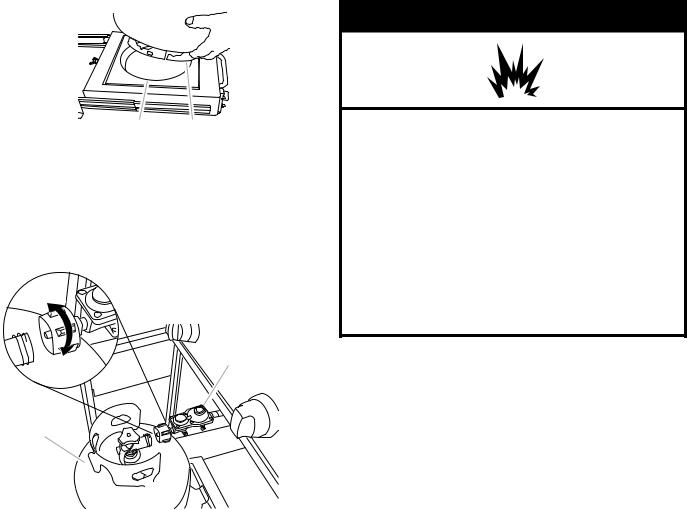
4.Tighten the locking screw against the bottom collar of the 20 lb LP gas fuel tank to secure.
A 
BC
A.Locking screw
B.Mounting hole
C.Bottom collar
5.Screw the gas pressure regulator/hose assembly to the 20 lb LP gas fuel tank as shown. (To disconnect, turn off the gas supply to the 20 lb LP gas fuel tank, then unscrew the gas pressure regulator/hose assembly from the 20 lb LP gas fuel tank as shown.)
connect
disconnect |
B |
A
A.20 lb LP gas fuel tank
B.Gas pressure regulator/hose assembly
6.Turn on the gas supply. Wait a few minutes for gas to move through the gas line.
7.Test all connections by brushing on an approved noncorrosive leak-detection solution. Bubbles will show a leak. Correct any leak found.
8.Slide the tank tray back into the cabinet and lock into place.
9.The batteries are not factory installed. The 1.5-volt “D” size alkaline batteries are located in the accessory box on the grill grate. Install the batteries at this time following the instructions in the “Replacing the Batteries” section.
10.Go to “Plug in Grill” in this section.
Gas Connection to Natural Gas or Local LP Gas
 WARNING
WARNING
Explosion Hazard
Use a new CSA International approved “outdoor” gas supply line.
Securely tighten all gas connections.
If connected to LP, have a qualified person make sure gas pressure does not exceed 11” (28 cm) water column.
Examples of a qualified person include:
licensed heating personnel,
authorized gas company personnel, and authorized service personnel.
Failure to do so can result in death, explosion, or fire.
This installation must conform with local codes and ordinances. In the absence of local codes, installations must conform with either the National Fuel Gas Code ANSI Z223.1, or CAN/CGAB149.1 Natural Gas and Propane installation code.
Copies of the standards listed above may be obtained from:
CSA International
8501 East Pleasant Valley Rd.
Cleveland, Ohio 44131-5575
National Fire Protection Association
One Batterymarch Park
Quincy, Massachusetts 02269
1.Make gas connections.
A combination of pipe fittings must be used to connect the grill to the existing gas line.
■If local codes permit, use an outdoor flexible stainless steel tubing gas connector, design-certified by CSA International, to connect the grill to the rigid gas supply line. A ⁄" diameter line is recommended. Using a wrench to tighten, connect the gas supply to the grill. Use pipejoint compound on all non-flared male threads. Do not kink or damage the flexible connector when moving the grill.
12

■Pipe-joint compounds suitable for use with LP gas must be used. Do not use TEFLON®† tape.
A |
B |
C
D
A.New ANSI Z21.54 certified gray hose
B.Rear of grill
C.To Natural gas supply
2.Open the manual shutoff valve in the gas supply line. The valve is open when the handle is parallel to the gas pipe.
A
B
A.Closed valve
B.Open valve
3.Test all connections by brushing on an approved noncorrosive leak-detection solution. Bubbles will show a leak. Correct any leak found.
4.The batteries are not factory installed. The 1.5-volt “D” size alkaline batteries are located in the accessory box on the grill grate. Install the batteries at this time following the instructions in the “Replacing the Batteries” section.
5.Go to “Plug in Grill” in this section.
Plug in Grill
 WARNING
WARNING
Electrical Shock Hazard
Use only a UL listed, 14 gauge, 3 wire extension cord approved for outdoor use, marked W-A, with a maximum length of 50 ft.
Plug into a grounded 3 prong outlet.
Do not remove ground prong.
Do not use an adapter.
Failure to follow these instructions can result in death, fire, or electrical shock.
1.Plug a UL outdoor rated 14 gauge/3 wire extension cord (marked W-A) (maximum length 50 ft [15.2 m]) into the male receptacle on the back of the grill.
B
A
C
A.UL outdoor rated 14 gauge/3 wire extension cord
B.Male receptacle
C.Circuit breaker button
2.Plug extension cord into grounded 3-prong GFI outlet.
B
A
C
A. 3-prong ground plug
B. 3-prong polarized type outdoor GFI outlet
C. Ground prong
■ To avoid electrical shock, do not immerse cord or plugs in water or other liquid.
■ Unplug from the outlet when not in use and before cleaning. Allow to cool before putting on or taking off parts.
■ Do not operate any outdoor cooking gas appliance with a damaged cord, damaged plug, or after the appliance malfunctions or has been damaged in any manner. Contact the manufacturer for repair.
†®TEFLON is a registered trademark of E.I. Du Pont De Nemours and Company.
13
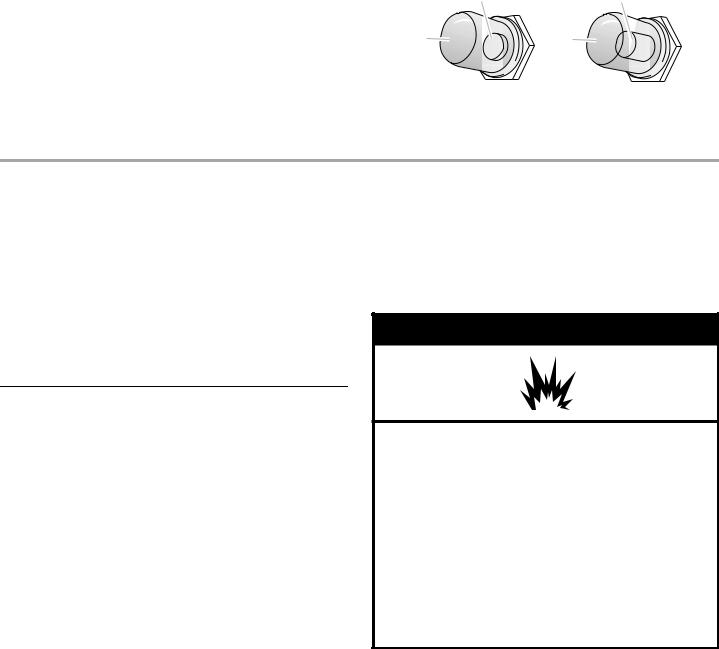
■Do not let the cord hang over the edge of a table or touch hot surfaces.
■Do not use an outdoor cooking appliance for purposes other than intended.
■When connecting, first connect plug to the outdoor cooking gas appliance then plug appliance into the outlet.
■Use only a Ground Fault Interrupter (GFI) protected circuit with this outdoor cooking gas appliance.
■Do not remove the ground prong or use with an adapter of 2 prongs.
■Use only extension cords with a 3 prong grounding plug rated for the power of the equipment and approved for outdoor use with a W-A marking.
NOTE: Check the circuit breaker on the back of the grill after plugging the grill into a 3-prong polarized type outdoor GFI outlet if there is a loss of electrical power to the grill. Reset the circuit breaker if the button is in the tripped position. Push in the rubber boot and button to reset.
B |
B |
A |
A |
A. Rubber boot |
A. Rubber boot |
B. Circuit breaker button in |
B. Circuit breaker button |
“set” position |
in “tripped” position |
3. Go to “Check and Adjust the Burners” section
GAS CONVERSIONS
NOTES:
■These instructions are for grill models that come equipped with the conversion kit for Local LP and Natural gas. For models that do not come equipped with the conversion kit: for conversion to Local LP order Regulator Part Number W10132702, or for conversion to Natural gas order LP to Natural Gas Conversion Kit Part Number W10118098. Use the conversion instructions included in the kit. See “Assistance or Service” section for information on ordering.
■The Fuel Remaining feature of the electronic grill display does not function with grills that are converted to Local LP (fixed piped) or Natural gas.
ToolsandPartsforGasConversion
Gather the required tools and parts before starting installation. Read and follow the instructions provided with any tools listed here.
Tools needed
■Phillips screwdriver
■Pipe wrench
■Adjustable wrench
■10 mm wrench
■6 mm socket and wrench or 6 mm nut driver
Parts supplied
■Brass connector
■10 mm socket and wrench or 10 mm nut driver
■Thin flat-blade screwdriver
■Pliers
■Pipe thread sealant certified for LP gas
■Convertible regulator 4" W.C. Natural, 11" W.C. LP
■Natural gas orifices
IMPORTANT: Gas conversions must be done by a qualified installer. Before proceeding with conversion, shut off the gas supply to the appliance prior to disconnecting the electrical power.
This kit is designed for use from sea level up to 2000 ft elevation. For higher elevations contact KitchenAid at 1-800-422-1230 in the U.S.A. or call 1-800-607-6777 in Canada.
 WARNING
WARNING
Explosion Hazard
Use a new CSA International approved “outdoor” gas supply line.
Securely tighten all gas connections.
If connected to LP, have a qualified person make sure gas pressure does not exceed 11” (28 cm) water column.
Examples of a qualified person include:
licensed heating personnel,
authorized gas company personnel, and authorized service personnel.
Failure to do so can result in death, explosion, or fire.
14
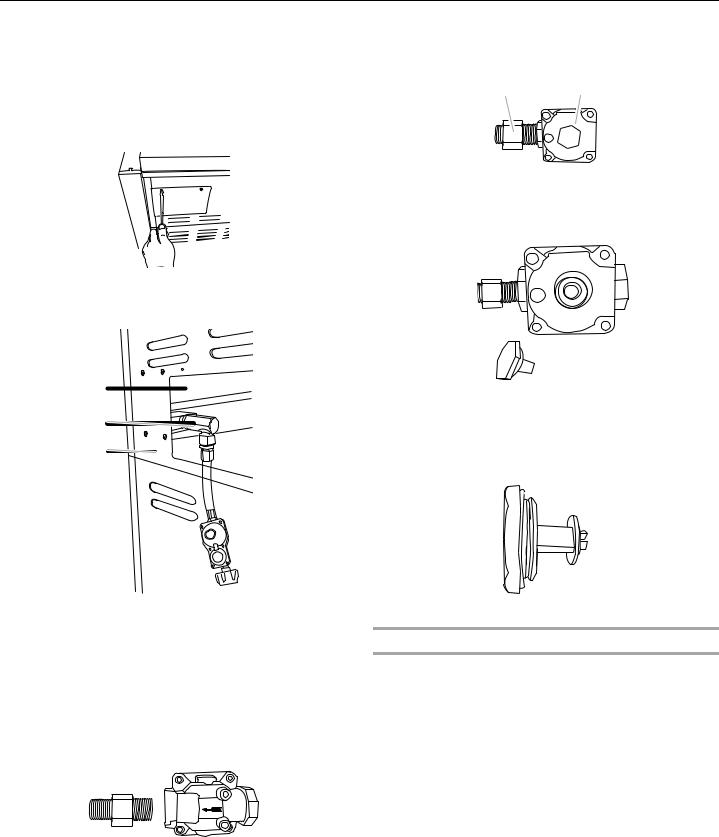
ConversiontoaLocalLPGasSupply
Installation of the regulator
1.Turn off the main gas supply valve.
2.Unplug grill or disconnect power.
3.Disconnect 20 lb LP gas fuel tank (if present).
4.Turn off all burner control valves.
5.Remove rear cover and 2 screws.
6.Use adjustable wrench to remove LP hose regulator from brass elbow. Use adjustable wrench to remove brass elbow from shutoff valve.
9.Use pipe wrench to install the convertible regulator. Brass cap will be facing up when tight.
A B
A.Brass connector
B.Convertible regulator
10.To set the appliance regulator for LP gas, use adjustable wrench to remove the brass cap on the convertible regulator.
A 
11. |
Examine the stem on the brass cap. The letters “NAT” should |
B |
be showing on the end of the plastic stem farthest away from |
the brass cap. |
|
12. |
Remove stem from cap, turn it over and snap stem back into |
C |
the cap so the letters “LP” are at the end of the stem farthest |
|
|
|
away from the brass cap. |
LP
D 
A.Manifold
B.Brass elbow
C.Rear of grill
D.Gas pressure regulator/hose assembly
7.Apply pipe sealant to the threads of the brass connector. Use pipe thread sealant that is certified for use with LP gas.
8.Use adjustable wrench to install brass connector (supplied) to shutoff valve.
NOTE: The arrow on the regulator must be pointing toward the brass connector.
13. Use adjustable wrench to reinstall cap onto regulator.
Make Grill Connections
Connect Local LP Gas Supply
1.Use pipe wrench to connect certified ½" (1.3 cm) gas supply pipe to inlet side of regulator from Fixed LP gas supply according to local codes requirements. Use pipe thread sealant that is certified for use with LP gas at connections where required. There must be a certified manual shutoff valve in the gas supply line near the grill for easy access.
2.Turn on the gas supply to the grill.
3.Test all connections by brushing on an approved noncorrosive leak-detection solution. Bubbles will show a leak. Correct any leaks found.
Record Conversion
In the last page of the Use and Care Guide, write “Converted to Local LP Gas Supply.” Also record the conversion date and the technician/company that performed the conversion.
15

ConversionfromLPGastoNaturalGas
Installation of the regulator
1.Turn off the main gas supply valve.
2.Unplug grill or disconnect power.
3.Disconnect 20 lb LP gas fuel tank (if present).
4.Turn off all burner control valves.
5.Remove rear cover and 2 screws.
6.Use adjustable wrench to remove LP hose regulator from brass elbow. Use adjustable wrench to remove brass elbow from shutoff valve.
A 
B 

C 
D 
A.Manifold
B.Brass elbow
C.Rear of grill
D.Gas pressure regulator/hose assembly
7.Apply pipe sealant to the threads of the brass connector. Use pipe thread sealant that is certified for use with LP gas.
8.Use adjustable wrench to install brass connector (supplied) to shutoff valve.
NOTE: The arrow on the regulator must be pointing toward the brass connector.
9.Use pipe wrench to install the convertible regulator. Brass cap will be facing up when tight.
A B
A.Brass elbow
B.Convertible regulator
10.To make sure the regulator is set for Natural gas, use adjustable wrench to remove brass cap on appliance regulator.
11.Examine the stem on the brass cap. If the letters “NAT” are not showing on the end of the plastic stem farthest away from the brass cap, remove stem from cap, turn it over and snap stem back into the cap so the letters “NAT” are at the end of the stem farthest away from the brass cap.
NAT
12. Reinstall cap onto convertible regulator.
Change the main grill burner valve orifices
1.Manually remove all of the grates, sear plate, and burners.
2.Remove the 2 screws that hold the burner in place. Remove gas burner from the grill.
A
A. Two screws
16
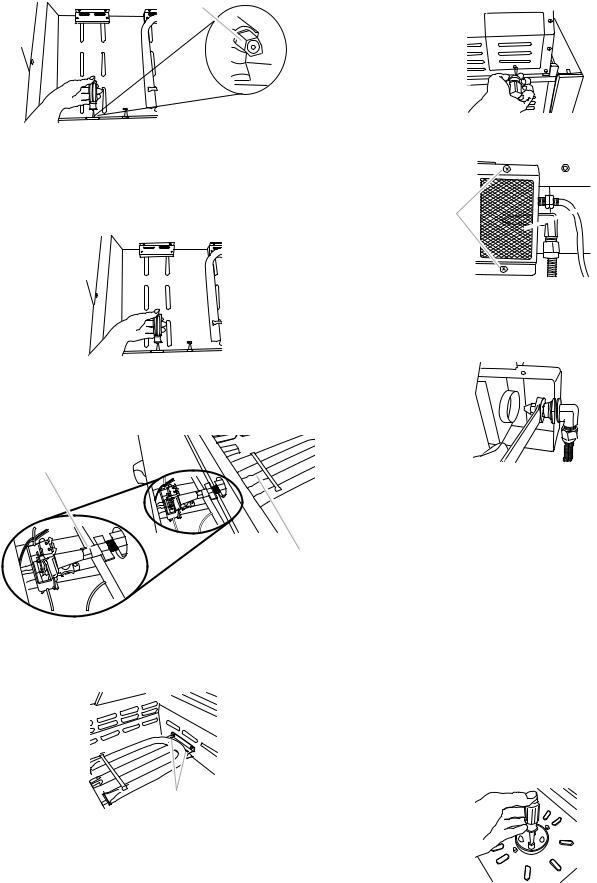
3.Use 6 mm socket and wrench or 6 mm nut driver to remove the brass orifices from the end of the gas valves.
A
A.Grill burner orifice
4.Install new 2.34 mm orifices supplied with this kit to the end of the gas valve. Use 6 mm socket and wrench or 6 mm nut driver to tighten.
NOTE: The number 2.34 is stamped on the orifice for identification.
A
A.Grill burner orifice
5.Replace burner by sliding the middle tube (venturi) over the orifice.
A
B
A.Burner/orifice connection
B.Burner
6.Reattach gas burner using 2 screws.
A
A.Two screws
7.Repeat the procedure for each grill burner.
Change the Rotisserie-infrared burner orifice(s)
1.Remove the access cover and screw at the back of the grill hood with a Phillips screwdriver.
2.Use Phillips screwdriver to remove 2 screws holding the spider guard to the burner.
A
B
A.Spider guard
B.Two screws
3.Use 10 mm wrench to remove the brass orifice located at the end of the supply pipe.
4.For models with 1 rotisserie burner:
Install 1.9 mm orifice supplied with this kit to the end of the supply pipe. Use 10 mm wrench to tighten.
For models with 2 rotisserie burners:
Install 1.55 mm orifice supplied with the kit to the end of the supply pipe. Use 10 mm wrench to tighten.
NOTE: The number 1.9 mm or 1.55 mm is stamped on the orifice for identification.
5.Replace the spider guard and secure with the 2 screws removed in Step 2.
6.Repeat the procedure for each rear burner.
Change the Side burner orifices
(for models equipped with side burner)
1.Remove the side burner grates.
2.Remove the burner caps. The caps are interlocked to the burner base. Twist and lift the burner caps to remove.
3.Use 10 mm socket and wrench or 10 mm nut driver to remove the brass orifices from inside the burner base.
17
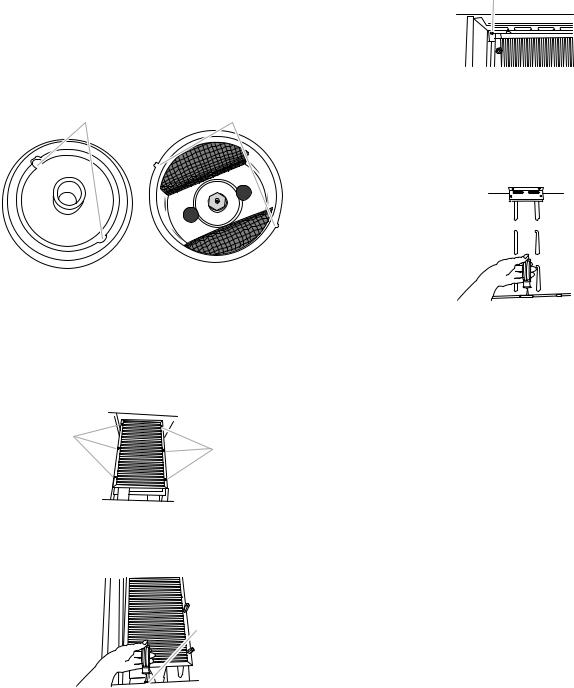
4.Use 10 mm socket and wrench or 10 mm nut driver to install the new 2.1 mm orifices supplied with this kit.
NOTE: The number 2.1 is stamped on the orifice for identification.
5.Repeat the procedure for the other burner.
6.Replace the burner top and caps. Align the notches in the bottom of the burner top with the tabs on the burner base and twist until the burner top is seated on the burner base. You will feel it drop into the deep notch.
A B
A.Burner top notches
B.Burner base tabs
7.Replace the side burner grates.
Change the Sear burner orifices
(for models equipped with sear burner)
1.Remove the sear burner cover screws. Set the screws and cover aside.
A
A
A.Sear burner cover screws
2.Remove the burner igniter mounting screws.
3.Loosen the sear burner plate, located next to the igniter.
A
A. Burner igniter mounting screws
4. Remove the sear burner mounting screws.
A
A.Sear burner mounting screws
5.Lift the sear burner out of the grill.
6.Use 6 mm socket wrench or 6 mm nut driver to remove the orifice. Install the new 2.34 mm orifice supplied.
NOTE: The number 2.34 is stamped on the orifice for identification.
7.Reinstall sear burner. Make sure that the igniter is out of the way to allow proper positioning of burner. Use Phillips screwdriver to attach the mounting screws.
8.Use Phillips screwdriver to reattach the igniter and sear burner plate.
9.Reinstall sear burner cover. Use Phillips screwdriver to attach mounting screws.
Hook up to Natural gas and Leak Test
1.Use pipe wrench to connect certified ¹⁄" (1.3 cm) gas supply pipe to inlet side of regulator from Natural gas supply according to local codes requirements. Use pipe thread sealant that is certified for use with LP gas at connections where required. There must be a certified manual shutoff valve in the gas supply line near the grill for easy access.
2.Turn on the gas supply to the grill.
3.Test all connections using an approved noncorrosive leakdetection solution. Bubbles will show a leak. Correct any leak found.
Record Conversion
1.The appliance nameplate is located inside the grill cabinet on the right-hand cabinet side. With a permanent marker, check the box next to “Natural gas” and mark through “LP - Propane.”
In the last page of the Use and Care Guide, write “Converted to Natural Gas.” Also record the conversion date and the technician/company that performed the conversion.
NOTE: Place LP gas parts in plastic parts bag for future use and keep with pack containing literature.
18

CheckandAdjusttheBurners
The burners are tested and factory-set for most efficient operation. However, variations in gas supply and other conditions may make minor adjustments to air shutter or low flame setting necessary.
It is recommended that a qualified person make burner adjustments.
NOTE: The rotisserie burner cannot be adjusted.
Checking and adjusting the grill burner flames requires removing the grate and sear plates.
Burner Flame Characteristics
The flames of the grill burners and side burners (on some models) should be blue and stable with no excessive noise or lifting (LP gas flames will have a slightly yellow tip). A yellow flame indicates not enough air. If flame is noisy or lifts away from the burner, there is too much air. Some yellow tips on flames when the burner is set to HI setting are acceptable as long as no carbon or soot deposits appear.
Main burner
³⁄ " - 1"
(1.9 - 2.5 cm)
on all burner ports with burners on "HI" setting
5.Remove the 2 screws that hold the burner in place. Remove gas burner from the grill.
A
A.2 screws
6.If flame is yellow (not enough air), turn air shutter adjustment screw counterclockwise.
If flame is noisy or lifts away from burner (too much air), turn air shutter adjustment screw clockwise.
A
A. Air shutter adjustment screw
A
A. Burner ports
Side burner
³⁄ " - 1"
(1.9 - 2.5 cm)
on all burner ports with burners on "HI" setting
Check that burners are not blocked by dirt, debris, insect nests, etc. and clean as necessary. If they are clean, adjust air shutters as needed.
IMPORTANT: Before adjusting air shutters, let burners cool completely.
To Adjust:
1.Light grill using information in the “Outdoor Grill Use” section.
2.Observe flame to determine which burners need adjustment and how the flame is acting.
3.Turn off the valve and wait until grill and burners cool completely.
4.Remove grill grates and sear plates.
Adjustment should be made clockwise or counterclockwise from ¹⁄ " (3.2 mm) to ¹⁄ " (6.4 mm).
7.Replace gas burner, sear plates and grates.
8.Light grill using information in the “Outdoor Grill Use” section. See “Burner Flame Characteristics.”
Low Flame Adjustment
If flame goes out on the “LO” setting, the low flame setting must be adjusted.
1.Turn off the valve and wait until grill and burners are cool.
2.Remove grill grates and sear plates.
3.Light grill using information in the “Outdoor Grill Use” section.
4.Turn burner to its lowest setting and remove knob.
5.Hold valve stem with pliers and insert a small flat-blade screwdriver into the shaft.
6.Watch the flame and slowly turn the screwdriver counterclockwise.
7.Adjust flame to minimum stable flame.
A
B
C
A.Valve stem
B.Small flat-blade screwdriver
C.Pliers
8.Replace the control knob and turn off the burner.
9.Repeat steps 3 through 8 for each burner if needed.
10.Replace the sear plates and grates after the burners have cooled.
19
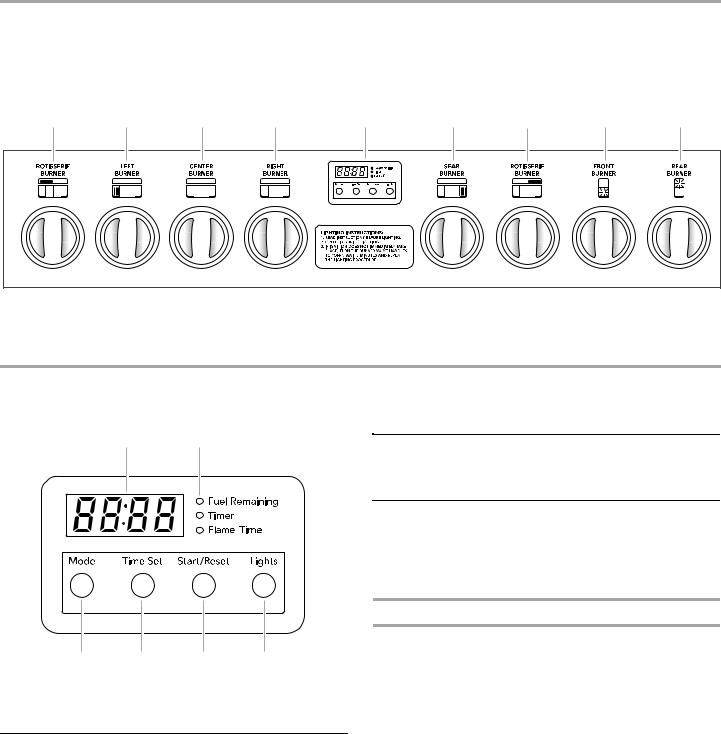
OUTDOOR GRILL USE
This manual covers several different models. The grill you have purchased may have some or all of the features listed. The locations and appearances of the features shown here may not match those of your model.
Control Panel
A B C D E F G H I
A.Left rotisserie burner control knob
B.Left grill burner control knob
C.Center grill burner control knob
D.Right grill burner control knob
E.Electronic grill display (on some models) Light switch button (on some models)
F. Sear burner control knob
G.Right rotisserie burner control knob
H.Front side burner control knob
I.Rear side burner control knob
ELECTRONIC GRILL DISPLAY
(onsomemodels)
A B
C |
D |
E |
F |
A. Electronic display |
|
D. Time set button |
|
B. Mode indicator lights |
E. Start/reset button |
||
C. Mode selection button |
F. Hood light on/off button |
||
Display
The display will turn on when a gas burner is lit. The display will default to “Fuel Remaining” for models using a 20 lb LP tank. For grills connected to local LP (fixed pipe) or natural gas the display will default to “Timer” mode.
This display will also turn on when the Mode, Timer or Start/ Reset button is pushed. The information displayed will be for the mode of the lit indicator light.
The display area will go blank 5 minutes after the last time that a button was pushed (except the light button).
If the display does not turn on or if an error code is displayed, see “Troubleshooting” section.
Start/Reset
The Start/Reset button starts the Timer and Flame Time™ cycle. This button also stops and resets these features.
Mode
The mode button selects features on the display control.
When the grill is not lit and the Mode button is pushed, it will only display the information for Modes 1 and 2. The grill must be lit for Mode 3 to be activated.
Mode 1 - Fuel Remaining Feature
The fuel remaining feature displays a calculated amount of time (hours and minutes) the grill can remain lit at the current gas usage rate before the 20 lb LP gas fuel tank runs out of fuel.
The Fuel Remaining can be checked when the grill is OFF.
To check fuel remaining with the grill OFF:
1.Press Mode button until the indicator light for “Fuel Remaining” comes on. “00:00” will appear in the display. After 10 seconds a calculated Fuel Time Remaining will appear in the display.
To check fuel remaining with the grill burners ON:
1.Press Mode button until the indicator light for “Fuel Remaining” comes on. “00:00” will appear in the display. After 10 seconds a calculated Fuel Time Remaining will appear in the display.
2.The fuel time remaining will be recalculated automatically 7-10 minutes after the grill has been lit.
NOTE: This recalculated display of fuel time remaining may increase when the grill is used on medium or low settings because the gas consumption is less.
20

When the 20 lb LP gas fuel tank is Low:
1.The Electronic Display will display “LO” when the 20 lb LP gas fuel tank is low.
NOTE: When the Electronic Display shows “LO”, your 20 lb LP gas fuel tank is low. The burner flames may seem smaller than when the tank is full.
Mode 2 - Timer
The Timer can be set in hours and minutes up to 12 hours and 59 minutes, then counts down the set time.
To Set:
1.Press the Mode button until the timer indicator light comes on.
2.Press the Time Set Button to increase the time by 1 minute or press and hold the Time Set button to increase the time rapidly.
3.When desired time is set, press the Start/Reset button once to start the timer countdown. When the set time ends, reminder tones will sound.
4.Press Start/Reset button to reset the Timer or cancel the reminder tones.
NOTE: The minute timer will continue counting down until the set time ends or the Start/Reset button is pushed to cancel the timer.
Mode 3 - Flame Time™ Feature
The Flame Time™ feature automatically shuts off gas to the burners 10 minutes after set time has expired. This feature can be set for 1 to 60 minutes.
Flame Time™ mode can be used to keep grill burning for a set amount of time for grilling or for burn off of the grill grates.
For burn off of grill grates
With the lid closed and the main burners on HI, residue will burn off the main grill grates. After the grill shuts off and is cool, the grates can be scraped off more easily. The recommended time for burn off is 45 minutes.
For Timed Grill “ON”
To set the amount of time for grilling, follow the steps the same as burn-off of grill grates except you need to light only the burners you wish to use and adjust the burner knob to desired grill setting. The hood can be up or down depending on your grilling preference.
To set Flame Time™ mode for burn-off:
1.Light all main burners and set them on HI and close the hood.
2.Press the “Mode” button until the indicator light for Flame Time™ feature comes on.
3.Press the “Time Set” button to the amount of time you want the grill to be on. The recommended time for burn off is
45 minutes.
4.Press “Start/Reset” button to start the Flame Time™ feature timer countdown. When the set time ends (00:00), the reminder tone will sound.
■If the Start/Reset button is pushed within 10 minutes after the Flame Time™ mode timer reaches 00:00 the fuel shutoff valve will not close automatically. The Flame Time™ mode timer can be reset and continue the burnoff or timed grill and the timer will count down the new set time.
■If the Start/Reset button is not pushed within 10 minutes after Flame Time™ mode timer reaches 00:00 the fuel shutoff valve will close automatically and the display for the Flame Time™ feature will be off. If the mode button is pushed, “E1” will appear in the display if there is at least one valve still turned on. The tone will sound one time. If Mode button is pushed a second time the Fuel time remaining will be displayed.
■If the valves are shut off while the Flame Time™ mode timer is counting down, it will stop counting and keep the data. If the start/reset button is pushed when the valves are turned on again, the Flame Time™ timer will continue to count from the last stored data.
5.Press Start/Reset button to cancel this feature or the reminder tones.
NOTE: All of the burner valves must be turned to the off position before grill can be lit after a Flame Time™ cycle has been used.
Lights
1.Press the lights button to turn the lights inside the grill hood “On” or “Off.”
NOTE: The power supply must be plugged in for lights to work. If lights do not work, see “Outdoor Grill Care” section for changing the light bulbs.
21

UsingYourOutdoorGrill
 WARNING
WARNING
Explosion Hazard
Do not store fuel tank in a garage or indoors.
Do not store grill with fuel tank in a garage or indoors.
Failure to follow these instructions can result in death, explosion, or fire.
 WARNING
WARNING
Fire Hazard
Do not use grill near combustible materials. Do not store combustible materials near grill. Doing so can result in death or fire.
 WARNING
WARNING
Food Poisoning Hazard
Do not let food sit for more than one hour before or after cooking.
Doing so can result in food poisoning or sickness.
Inspect the 20 lb LP Gas Fuel Tank Supply Hose
Inspect the gas pressure regulator/hose assembly before each use.
1.Open the right-hand drawer and slide 20 lb LP gas fuel tank out.
2.Inspect the entire gas pressure regulator/hose assembly for cuts, abrasions, or excessive wear.
3.If necessary, replace the gas pressure regulator/hose assembly before using the grill.
Contact the dealer and use only replacement hoses specified for use with the grill.
A
A. Gas pressure regulator/hose assembly
Check the Drip Tray Pans
Open the drip tray and check the drip pans for grease and other liquids. Clean the drip tray and pans often to avoid grease and other liquid buildup.
Water can build up in the drip tray and pans if the grill is not covered when not in use.
See Drip Tray in the “General Cleaning” section for emptying and cleaning the drip tray and pans.
The drip tray must be in place and pushed all of the way in when using the grill.
Prepare the Gas Supply
1.Open the hood completely. Do not light burners with the hood closed.
2.Make sure the control knobs are all turned to the OFF position.
Turn the Gas Supply On
1.For freestanding outdoor grills using a 20 lb LP gas fuel tank: Slowly open the 20 lb LP gas fuel tank valve.
NOTE: If flow limiting device activates, your grill may not light. If your grill does light, the flames will be low and will not heat properly. Turn 20 lb LP gas fuel tank valve and all control knobs off and wait 30 seconds. After shutting off the 20 lb LP gas fuel tank, very slowly open tank valve and wait 5 seconds before lighting.
2.For outdoor grills using gas supply source other than 20 lb LP gas fuel tank:
Open the manual shutoff valve in the gas supply line. The valve is open when the handle is parallel to the gas pipe.
22

Lighting the Grill and Infrared Sear Burner
1.Do not lean over the grill.
2.Select the burner you want to light. Push in and turn the grill burner control knob to LITE/HI, while continuing to hold it in.
3.You will see the igniter glow or hear the “snapping” sound of the spark (depending on your model). When burner is lit, release the knob. Turn knob to desired setting.
4.Repeat for each of the other burners as needed.
IMPORTANT: If burner does not light immediately, turn the burner knob to OFF and wait 5 minutes before relighting.
Manually Lighting Main Grill and Infrared Sear Burners
1.Do not lean over the grill.
2.Remove the manual lighting extension (see following illustration) and attach a match to the split ring.
Freestanding grills - righthand cabinet drawer or door
3.Strike the match to light it.
4.Guide the lit match between the grill grate and one of the slots in the sear plate.
5.Push in and turn the burner knob to LITE/HI for the burner closest to the lit match. The burner will light immediately. When burner is lit, turn knob to desired setting.
6.Repeat steps 3 through 5 for each main burner.
7.Remove match and replace manual lighting extension inside the cabinet drawer or door.
IMPORTANT:
If burner does not light immediately, turn the burner knob to OFF and wait 5 minutes before relighting.
If any burners do not light after attempting to light them manually, contact the KitchenAid Customer eXperience Center. See the “Assistance or Service” section.
UsingYourInfraredSearBurner
(onsomemodels)
Infrared grilling produces intense heat which quickly sears the meat. Searing locks in flavor and juices while allowing the outer surface to absorb smoke and food aroma that is produced as grease and drippings are vaporized by the burner. The result is a crisp, flavorful outside with a tender, juicy inside.
■Preheat the infrared sear burner for 5 minutes.
■Ensure that meats are fully thawed and that all excess fat is trimmed away prior to grilling.
■Leave the burner set to HI when placing food on the grill to sear.
■Use the sear burner to sear meat 1 to 2 minutes on each side, then move the meat to the main grill cooking surface to finish grilling to the desired doneness.
NOTE: View is shown with grates removed. Grates are to be in place when using the infrared sear burner.
UsingYourSideBurner
(onsomemodels)
 WARNING
WARNING
Burn Hazard
Do not let the burner flame extend beyond the edge of the pan.
Doing so can result in burns.
Lighting the Side Burner
1.Remove the side burner cover. Do not light burners with the cover on.
2.Do not lean over the grill.
3.Push in and turn the control knob to LITE/HI and hold in.
23
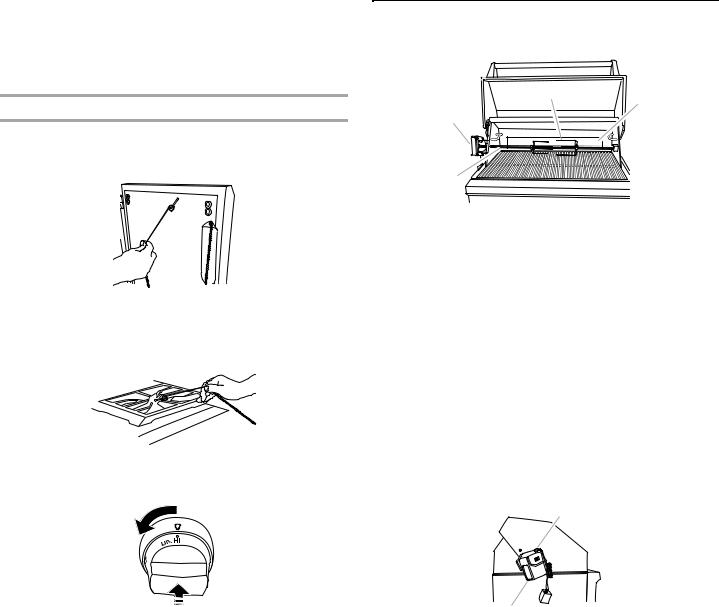
4.You will see the igniter glow or hear the “snapping” sound of the spark (depending on your model). When burner is lit, release the knob. Turn knob to desired setting.
5.Repeat for the other burner as needed.
IMPORTANT: If burner does not light immediately, turn the burner knob to OFF and wait 5 minutes before relighting.
Manually lighting the side burner
1.Do not lean over the grill.
2.Remove the manual lighting extension (see following illustration) and attach a match to the split ring.
Freestanding grills - righthand cabinet drawer or door
3.Strike the match to light it.
4.Guide the match to the burner you wish to light.
5.Push in and turn the burner knob to LITE/HI for the burner closest to the lit match. The burner will light immediately. When burner is lit, turn knob to desired setting.
6.Repeat steps 3 through 5 for each burner.
7.Remove match and replace manual lighting extension inside the cabinet drawer or door.
IMPORTANT:
If burner does not light immediately, turn the burner knob to OFF and wait 5 minutes before relighting.
If any burners do not light after attempting to light them manually, contact the KitchenAid Customer eXperience Center. See the “Assistance or Service” section.
UsingYourRotisserie
(optionalaccessoryonsomemodels)
C
D
A
B
A.Rotisserie motor
B.Spit rod
C.Rotisserie fork
D.Rotisserie burner
For best cooking results, do not use main grill burners when using the rotisserie.
The rotisserie system is designed to cook food from the rear using intense, searing infrared heat.
NOTE: To avoid product damage when not using the rotisserie, remove the motor and 500 mAmp transformer assembly and store indoors. Remove the spit rod and forks. Store out of the reach of children.
To Use:
1.Remove warming shelf.
2.Mount rotisserie motor on the grill’s mounting bracket. Position it securely into support bracket slots. Plug singleprong plug of the 500 mAmp transformer assembly into rotisserie motor.
B
A
A.Rotisserie motor
B.Single-prong power cord
3.To load the spit rod, slide one of the rotisserie forks onto the spit rod with prongs facing inward.
4.Push spit rod through the center of the food, then slide second rotisserie fork into position.
5.Center the food and rotisserie forks on spit rod and tighten wing nuts on the rotisserie forks. If necessary, secure loose food portions with butcher’s string only.
24
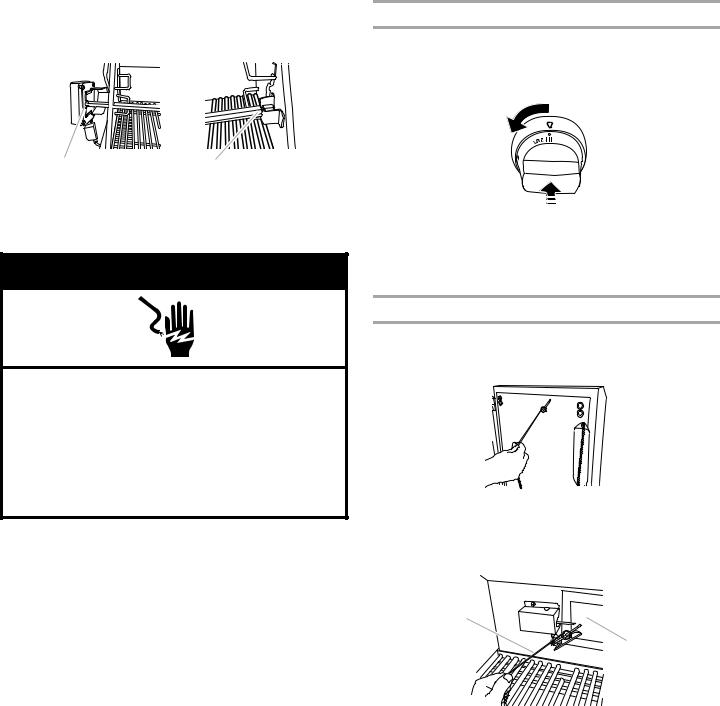
6.Once the food is positioned on spit rod, place pointed end of rod through the hole in the left side of the grill and into the rotisserie motor, then lower the notched end of the spit rod onto the support bracket on the opposite side.
A B
A.Pointed end of spit rod
B.Notched end of spit rod
7.Check that food is centered with the rotisserie burner. If not, loosen wing nuts, reposition food and retighten wing nuts.
 WARNING
WARNING
Electrical Shock Hazard
Plug into a grounded 3 prong outlet.
Do not remove ground prong.
Do not use an adapter.
Do not use an extension cord.
Failure to follow these instructions can result in death, fire, or electrical shock.
8.Plug into the grounded 3 prong outlet on the back of the grill.
■To avoid electrical shock, do not immerse cord or plugs in water or other liquid.
■Unplug from the outlet when not in use and before cleaning. Allow to cool before putting on or taking off parts.
■Do not operate any outdoor cooking gas appliance with a damaged cord, damaged plug, or after the appliance malfunctions or has been damaged in any manner. Contact the manufacturer for repair.
■Do not let the cord hang over the edge of a table or touch hot surfaces.
■Do not use an outdoor cooking appliance for purposes other than intended.
■When connecting, first connect plug to the outdoor cooking gas appliance then plug appliance into the outlet.
■Use only a Ground Fault Interrupter (GFI) protected circuit with this outdoor cooking gas appliance.
■Do not remove the ground prong or use with an adapter of 2 prongs.
9.Turn on the rotisserie motor and light the rotisserie burner. See the following “Lighting the Rotisserie Burner” section.
Lighting the Rotisserie Burner
1.Do not lean over the grill.
2.Push in and turn the control knob to LITE/HI. You will see the igniter glow or hear the “snapping” sound of the spark (depending on your model).
3.When the rotisserie burner lights, continue to hold the knob in for another 10 seconds, then release the knob and burner will stay lit.
IMPORTANT: If the rotisserie burner does not light immediately, turn the burner knob to OFF and wait 5 minutes before relighting.
Manually Lighting the Rotisserie Burner
1.Do not lean over the grill.
2.Remove the manual lighting extension (see following illustration) and attach a match to the split ring.
Freestanding grills -
right-hand cabinet drawer or door
3.Strike the match to light it.
4.Gently hold the lit match close to the rotisserie burner.
A
B
A.Lighting extension
B.Rotisserie burner
25
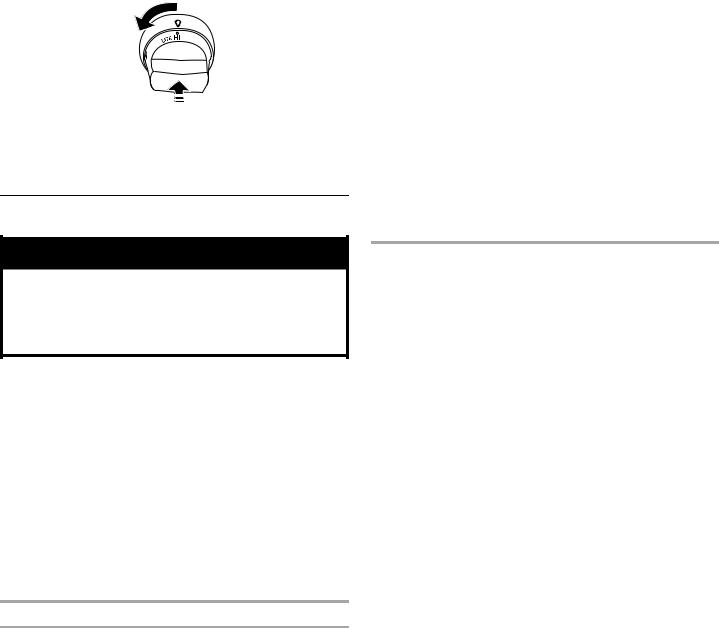
5.Push in and turn the control knob to LITE/HI. Hold this knob in for 10 seconds after the burner is lit. You may see the igniter glow or hear the “snapping” sound of the spark (depending on your model) until after the knob is released.
IMPORTANT: If the rotisserie burner does not light immediately, turn the rotisserie burner control knob to “OFF” and wait 5 minutes before relighting.
6.Remove the match and replace the manual lighting extension inside the cabinet drawer or door.
RotisserieCookingTips
 WARNING
WARNING
Food Poisoning Hazard
Do not let food sit for more than one hour before or after cooking.
Doing so can result in food poisoning or sickness.
Rotisserie cooking rotates food in front of the rotisserie burner, creating an intense heat for searing the outside and sealing in natural juices.
The rotisserie burner reaches cooking temperatures in about
1 minute. It is not necessary to preheat when using the rotisserie.
■Select tender meat and poultry.
■Allow at least 1" (2.5 cm) space between rotisserie burner and the food.
■To make cleanup easier, place a pan under the food to catch drippings.
■The hood can be opened or closed, but when using the rotisserie with the smoker the hood should be closed.
■Add barbecue sauce or glaze only during the last 10 minutes of cooking to keep sauce from burning.
Trussing Poultry for the Rotisserie
1.Load the spit rod by sliding one of the forks on the rod, with the prongs facing inward. Tighten the screw to keep it from slipping.
2.Push the rod through the center of the bird.
3.Cut 24" (61 cm) of butcher’s string and center it under the bird, breast side up.
4.Wrap each end of the string around the wings; catch each wing tip. Bring the string tightly together at the top of the breast and knot. It is not necessary to cut off the extra string.
5.Cut another 20" (50.8 cm) of string and lay it under the back of the bird. Wrap it around the tail then around the spit rod, cinching tightly.
6.Cross the legs on top of spit rod; tie string around the crossed legs.
7.Connect the twine holding the legs, to the string holding the wings, and knot. Cut off any bits of hanging string.
8.Slide on the second fork pushing the tines into the drumsticks.
9.Center the food and forks on the rod and tighten the thumbscrews. The bird should be firmly in place on the rotisserie spit rod.
ROTISSERIE CHART
Use a portable meat thermometer to check internal doneness of the food.
Turn off rotisserie burner when meat thermometer reads 5°F/3°C lower than desired internal temperature. Continue rotating, hood closed, for 10 minutes before carving.
Timing is affected by weather conditions such as wind and outside temperature.
Food |
Weight |
Internal |
Approximate |
|
|
Doneness or |
Grilling Time |
|
|
Temperature |
(min/lb) |
|
|
(°F/°C) |
|
|
|
|
|
Beef |
|
|
|
|
|
|
|
Roasts |
4-6 lbs |
Medium-rare |
15-20 |
Rib Eye |
1.5-2.2 kg |
(145°F/ 63°C) |
|
Sirloin Tip |
|
Medium |
20-25 |
Rib, boneless |
|
(160°F/71°C) |
|
|
|
|
|
Poultry |
|
|
|
|
|
|
|
Chicken |
3-6 lbs |
Breast |
25-30 |
|
1.1-2.2 kg |
(170°F/ 77°C) |
|
|
|
Thigh |
25-30 |
Turkey, whole |
7-10 lbs |
(180°F/82°C) |
|
Breast |
11-20 |
||
|
2.6-3.7 kg |
(170°F/77°C) |
|
|
|
Thigh |
11-20 |
|
|
(180°F/82°C) |
|
|
|
|
|
Lamb |
|
|
|
|
|
|
|
Boneless leg |
4-7 lbs |
Medium |
20-25 |
|
1.5-2.6 kg |
(160°F/71°C) |
|
|
|
|
|
Pork |
|
|
|
|
|
|
|
Loin roast, |
4-6 lbs |
Medium |
20-23 |
boneless |
1.5-2.2 kg |
(160°F/71°C) |
|
|
|
|
|
26
